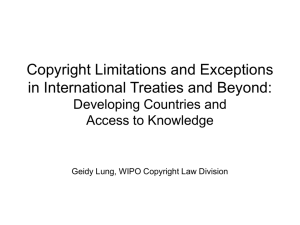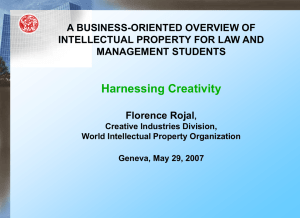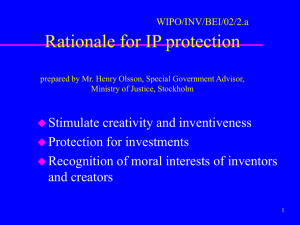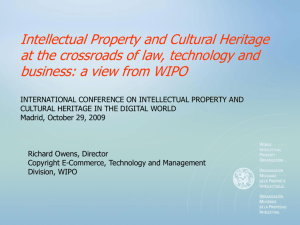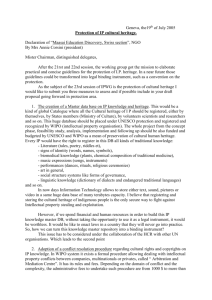International Copyright and Libraries
advertisement
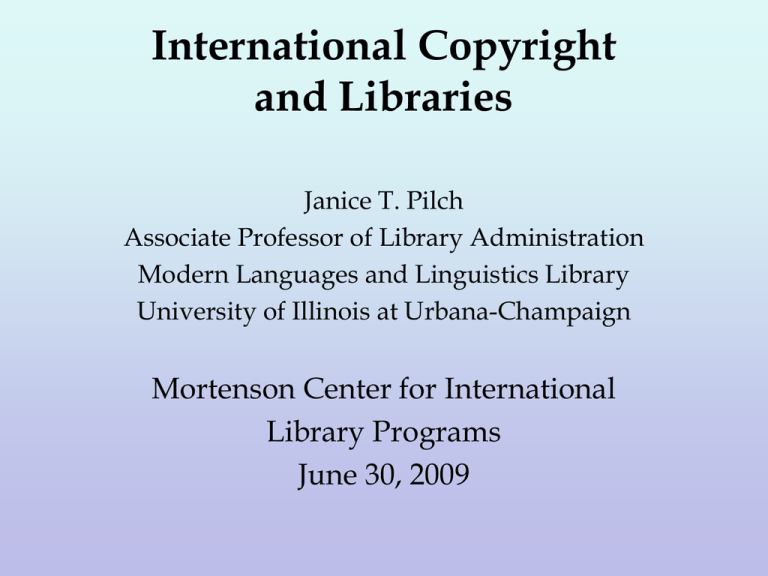
International Copyright and Libraries Janice T. Pilch Associate Professor of Library Administration Modern Languages and Linguistics Library University of Illinois at Urbana-Champaign Mortenson Center for International Library Programs June 30, 2009 International copyright landscape • Rapid growth in information technology since 1980s • View of intellectual property as key to economic growth in post-industrial age • Culture of copying – The Web has been called “one of the world’s largest libraries and surely the world’s largest copying machine.” -- Committee on Intellectual Property Rights and the Emerging Information Infrastructure, The Digital Dilemma: Intellectual Property in the Information Age (Washington, D.C.: National Academy Press, 2000), 23. • Growth in pirate industries and fighting piracy International copyright principles • Not a defined body of law • Terms of international treaties and agreements are implemented in national laws • Operates on basis of relations between nations – Country of origin – Protecting country • Operates on principles of: – Territoriality – National treatment – Minimum protection International copyright principles • Role of national law—governs use within that nation of eligible foreign works – Whether a work is copyrighted in U.S. – Copyright term – How a work may be used • Law of country of origin generally determines – Issues of ownership and transfer – Definition of author • Challenges in the digital age - National laws differ - Copyright is nation-centric, the Internet is not International treaties, conventions, and agreements • World Intellectual Property Organization (WIPO) – Berne Convention for the Protection of Literary and Artistic Works (1886) • U.S. entry into force March 1, 1989 • PRC entry into force October 15, 1992 • Oldest international copyright treaty • 164 members International treaties, conventions, and agreements - WIPO Copyright Treaty (1996) • U.S. entry into force March 6, 2002 • PRC entry info force June 9, 2007 • Extends Berne Convention into digital age • 70 members – WIPO Performances and Phonograms Treaty (1996) • U.S. entry into force May 20, 2002 • PRC entry into force June 9, 2007 • Extends Berne Convention into digital age • 68 members International treaties, conventions, and agreements • United Nations Educational, Scientific and Cultural Organization (UNESCO) – Universal Copyright Convention (1952) • U.S. entry into force September 16, 1955 • PRC entry info force October 30, 1992 • Alternative to Berne Convention-- Berne Convention has priority if nations belong to both treaties • 100 parties to 1952 convention; 65 parties to 1972 convention International treaties, conventions, and agreements • World Trade Organization (WTO) – Agreement on Trade-Related Aspects of Intellectual Property Rights (TRIPS) (1995) • U.S. entered January 1, 1995 • PRC entered December 11, 2001 • Enforces Berne Convention • 153 members International treaties, conventions, and agreements • Regional copyright treaties and agreements • Bilateral treaties and agreements – U.S.-China bilateral agreement of January 13, 1904 Not considered by PRC as binding. In the territory administered on Taiwan, the treaty is considered to be in force – U.S.-China bilateral agreement of November 30, 1948 – U.S.-PRC bilateral agreement of March 17, 1992 National copyright law Terms of international treaties and agreements are implemented in national laws • Copyright Law of the People’s Republic of China (1990), as amended (2001) • Regulations for the Implementation of the Copyright Law of the People’s Republic of China (2002) • Regulations on the Protection of the Right of Communication Via Information Network (2006) Aspects of international copyright protection common to national laws • • • • • • • • Formalities Criteria for protection Authorship and ownership Protected subject matter Unprotected subject matter Moral rights (personality rights) Economic rights (property rights) Limitations and exceptions (flexibilities) Aspects of international copyright protection common to national laws • Duration of copyright – Moral rights – Economic rights • Provisions for copyright restoration under Berne Convention • Related rights (rights of performers, producers of sound recordings, broadcasting organizations) U.S. copyright law • Copyright Act of 1976 (17 United States Code) – Took effect on January 1, 1978 – Has been amended numerous times – http://www.copyright.gov/title17 • Formalities no longer required • Requirements for copyright protection in U.S. – Originality – Fixation in tangible medium of expression – Minimal creativity U.S. copyright law • What is protected in U.S. – – – – – Literary works Musical works, including any accompanying words Dramatic works, including any accompanying music Pantomimes and choreographic works Pictorial, graphic, and sculptural works • Works of visual art – Motion pictures and other audiovisual works – Sound recordings – Architectural works U.S. copyright law • What is not protected in U.S. – Ideas, procedures, processes, systems, methods of operation, concepts, principles, discoveries – U.S. federal government works – Facts – Works in public domain • Who owns copyright in U.S. – Authors (initial authorship) – Employers for works made for hire – Assignees (not licensees) Exclusive rights of copyright holders in U.S. 1. 2. 3. 4. 5. 6. Reproduction [Section 106(1)] Preparing a derivative work [Section 106(2)] Public distribution [Section 106(3)] Public performance [Section 106(4)] Public display [Section 106(5)] Public performance by means of a digital audio transmission [Section 106(6)] Limitations and Exceptions in U.S. Section 107 (fair use) Section 108 (library and archival exception) Section 109 (first sale doctrine) Sections 110 and 112 (performance and display of works for classroom use) U.S. copyright duration in eligible foreign works – If published before 1923, in public domain – If published from 1923-1977, 95 years from date of publication – If created, but not published, before 1978, life + 70 or 12/31/2002, whichever is greater – If created before 1978 and published between 1978 and 12/31/2002, life + 70 or 12/31/2047, whichever is greater – If created from 1978- life + 70 (for works of corporate authorship, works for hire, anonymous and pseudonymous works, the shorter of 95 years from publication or 120 years from creation) Common questions concerning international works • Is the work protected by copyright in the U.S. today? • International copyright and digitization projects • International copyright and the Internet • How to obtain copyright permission to use a foreign work U.S. copyright assessment: Example In the U.S. a work may be protected by copyright if the work was first published in the U.S. or in a foreign nation that, on the date of first publication, was a treaty party. Pasternak, Boris. Doktor Zhivago. Moscow: Knizhnaia palata, 1989 [in Russian] Investigation • • • • • • Published or unpublished? Published Date of creation or first publication? November 1957 First edition or subsequent edition? Subsequent Place of first publication: Italy Focus narrows to the first edition. First published simultaneously in another country? No. Country of origin: Italy – Date when U.S copyright relations established with Italy: October 31, 1892 • Who is the author? Boris Pasternak (1890-1960) Investigation • Nationality of the author? Citizen of USSR. Other relevant facts? Posthumously rehabilitated in 1987. • Is the work anonymous/pseudonymous? No • Was the work first published posthumously? No. • Type of work: literary work • Compilation? No, although poems in the novel are individual works • Derivative work? Yes. • Work for hire? Yes • Was the work first published with notice and renewed in the U.S. Copyright Office? Yes Investigation • Was the work first published lawfully? Yes. • How long is the original work protected in the U.S.? 95 years from date of publication, through 2052. Investigation continues Back to 1989 Moscow publication, in Russian. • Russian-language edition by University of Michigan Press appeared in December 1958, with a copyright notice in Feltrinelli’s name and with a date of 1959. • Russian-language edition printed in Milan by Feltrinelli Editore Milano in 1958 or early 1959. There is no date on the title page, and there is a copyright notice indicating a date of November 1957. Investigation continues • Copyright in Russian version used for the 1989 text - 1957/1958/1959 publications expire in U.S. in 2052/2053/2054* - No new copyright in the 1989 text of the novel • Copyright in new matter published in 1989 based on lifespan of authors/artists. • Foreword* • Afterword* • Artistic design* • Copyright in first edition of 1957 published in Italy, expires in U.S. in 2052.* *Final assessment involves five layers of copyright! International copyright and digitization projects • Due diligence involves a case-by-case analysis and legal expertise • Not feasible to determine status of individual works • Mass identification of copyright status • Hathi Trust Repository cut-off date for published works of 1869 See http://www.hathitrust.org/rights_database • Google cut-off date Practical copyright questions: libraries • Preservation of published and unpublished works • Interlibrary loan of physical volumes • Interlibrary loan of copies • Document delivery of copies • Direct use copies • Unsupervised copying • Public display of works in exhibits • Print and electronic reserves • Digitization projects Practical copyright questions: teaching • • • • • • • Classroom teaching Distance education Classroom handouts Academic coursepacks Print and electronic reserves Use of course management software Web 2.0 applications Practical copyright questions: research • • • • • • • Term papers Assignments Class projects Delivering classroom presentations Use in publications Compiling material for research Theses and dissertations International copyright and the Internet • Law of a foreign country can apply to a dispute involving Internet activity originating in U.S. but committed in and violating the law of that country – LICRA (League Against Racism and Antisemitism) v. Yahoo! Inc. (France) • See David G. Post, “Whose Law? The Problem of Jurisdiction on the Internet,” Educause Live Web Seminar, September 15, 2005, at http://www.educause.edu/live – International Music Score Library Project • See http://www.michaelgeist.ca/content/view/2308/125/ and http://www.michaelgeist.ca/index.php?option=com_content&t ask=view&id=2333&Itemid=159 • Hague Convention on Choice of Court Agreements International copyright permissions: General practices 1. Identify copyright holder 2. Contact copyright holder directly –or— contact a collective rights organization to negotiate permissions 3. Draft permissions letter 4. Negotiate permissions agreement, possibly involving fee 5. Obtain signed permissions agreement Lack of response does not substitute for permission Challenges in international copyright Factors related to traditional copyright law: • • • • Levels of copyright protection vary across nations. Copyright laws are frequently amended. Copyright assessments require time and legal expertise. Copyright holders are often difficult to identify and locate. • Legislative solutions are needed for orphan works. • Growth in licensing of digital resources often hinders application of copyright limitations and exceptions. Challenges in international copyright Factors related to digital technology: • Copyright is territorial, the Internet is not. • Digital technology is only useful when there is national infrastructure and capacity to support it. • Digital technology makes possible new types of uses that are not addressed in national copyright laws. • Growth in licensing of digital resources often hinders application of copyright limitations and exceptions. Challenges in international copyright Economic factors: • Powerful private interests pressure governments to adopt higher standards for IP protection to retain their economic rights in IP. • Limitations and exceptions to copyright, which exist as a counterbalance to exclusive rights, have not expanded at an equal pace with enhanced rights and obligations. • Growth in licensing of digital resources often hinders application of copyright limitations and exceptions. Copyright should serve as a means and a stimulus for knowledge, innovation, and creativity for people everywhere. It is not an end in itself. International copyright advocacy for libraries • Library Copyright Alliance (LCA) http://www.librarycopyrightalliance.org • Electronic Information for Libraries (eIFL.net) http://www.eifl.net/cps/sections/home • International Federation of Library Associations and Institutions (IFLA) http://www.ifla.org WIPO Standing Committee on Copyright and Related Rights Copyright limitations and exceptions • Study on Copyright Limitations and Exceptions for Educational Activities (requested) • Study on Copyright Limitations and Exceptions for Libraries and Archives, by Kenneth D. Crews (2008) http://www.wipo.int/meetings/en/archive_docs.jsp?organisatio n=WIPO&doc_code=sccr/17/2&doc_title=&doc_author=&doc_l ang_code= • Study on Copyright Limitations and Exceptions for the Visually Impaired, by Judith Sullivan (2007) http://www.wipo.int/meetings/en/doc_details.jsp?doc_id=75696 WIPO Standing Committee on Copyright and Related Rights • Automated Rights Management Systems and Copyright Limitations and Exceptions, by Nic Garnett (2006) http://www.wipo.int/meetings/en/doc_details.jsp?doc_id=59952 • WIPO Study on Limitations and Exceptions of Copyright and Related Rights in the Digital Environment, by Mr. Sam Ricketson (2003) http://www.wipo.int/meetings/en/doc_details.jsp?doc_id= 16805 WIPO Standing Committee on Copyright and Related Rights • Proposed Treaty for Improved Access for Blind, Visually Impaired and Other Reading Disabled Persons http://www.keionline.org/content/view/210/1/ • Statement of Principles on Copyright Exceptions and Limitations for Libraries and Archives, May 2009 (IFLA, EIFL, LCA) http://www.ifla.org/en/publications/statement-of-principles- oncopyright-exceptions-and-limitations-for-libraries-and-archi WIPO Standing Committee on Copyright and Related Rights • WIPO International Workshop on Digital Preservation and Copyright (July 2008) – International Study on the Impact of Copyright Law on Digital Preservation: A Joint Report of The Library of Congress National Digital Information Infrastructure and Preservation Program, The Joint Information Systems Committee, The Open Access to Knowledge (OAK) Law Project, The SURF Foundation http://www.digitalpreservation.gov/library/resources/pubs/ docs/digital_preservation_final_report2008.pdf WIPO Intergovernmental Committee on Intellectual Property and Genetic Resources, Traditional Knowledge and Folklore • Longstanding efforts to find solution to protection of traditional cultural expressions • WIPO IGC efforts toward possible sui generis protection of Traditional Cultural Expressions (2001- ) • WIPO Creative Heritage Project http://www.wipo.int/tk/en/folklore/culturalheritage WIPO Intergovernmental Committee on Intellectual Property and Genetic Resources, Traditional Knowledge and Folklore • Need for recognition of and respect for traditional cultures • Libraries play a primary role in preserving and providing access to cultural heritage • American Library Association, Office for Information Technology Policy Conference on Cultural Heritage and Living Culture: Defining the U.S. Library Position on Access and Protection of Traditional Cultural Expression (November 12-14, 2008) http://www.ala.org/tce/ WIPO Committee on Development and Intellectual Property WIPO Development Agenda, a set of 45 proposals adopted on September 2007 by the WIPO General Assembly: • Aims to address inequities in the IP system and to improve information technology infrastructure in developing and least developed countries • Seeks to ensure that IP law and policy continue to serve the public good by encouraging and rewarding innovation and creativity in a balanced way in all parts of the world WIPO Committee on Development and Intellectual Property International library community advocates for: • a fair balance between intellectual property protections and the public interest • minimizing levels of copyright protection in developing and least developed countries • a robust public domain • adequate limitations and exceptions for the purposes of education, scholarship, and creativity; and preservation of information • access to knowledge and technology to foster innovation, material progress, and welfare WIPO Committee on Development and Intellectual Property • the goals of information literacy • bridging the digital divide • library participation in local efforts at technical assistance and capacity building in developing and least developed countries • balanced IP education in developing and least developed countries • new approaches to the licensing of copyrighted works • the social good that results from a true balance between intellectual property protections and the public interest. Additional resources • World Intellectual Property Organization (WIPO): http://www.wipo.int/copyright/en/ • WIPO Collection of Laws for Electronic Access: http://www.wipo.int/clea/en/index.jsp • UNESCO website, including database of national copyright laws: http://portal.unesco.org/culture/en/ev.phpURL_ID=35170&URL_DO=DO_TOPIC&URL_SECTION=471.html http://portal.unesco.org/culture/en/ev.phpURL_ID=14076&URL_DO=DO_TOPIC&URL_SECTION=201.ht ml • World Trade Organization website, section on intellectual property: http://www.wto.org/english/tratop_e/trips_e/trips_e.htm Additional resources • International Federation of Library Associations and Institutions: http://www.ifla.org • Electronic Information for Libraries http://www.eifl.net/cps/sections/home • International Federation of Reproduction Rights Organizations: http://www.ifrro.org/show.aspx?pageid=home • Knowledge Ecology International: http://www.keionline.org/ • A2K (Access to Knowledge) list by CPTech: http://www.cptech.org/a2k/ • Intellectual Property Watch: http://www.ip-watch.org/weblog/ Thank you! Janice T. Pilch Associate Professor of Library Administration Modern Languages and Linguistics Library University of Illinois at Urbana-Champaign E-mail: pilch@illinoisedu
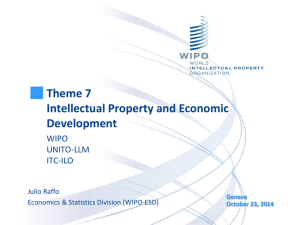
![Invitation [word format]](http://s3.studylib.net/store/data/007096478_1-54334bf5ab877bf1ebd233e686a3f8bb-300x300.png)
